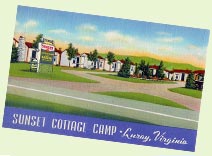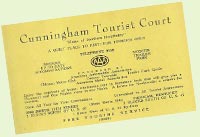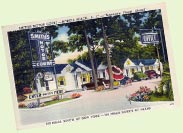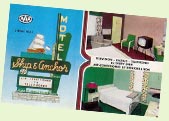 In 1900, there were 8,000 registered automobiles in America. By 1930, that number had jumped to an astounding 23 million! With travelers abandoning trains and horses in favor of the Model T and the lure of the open – if often times bumpy, unpaved, and poorly marked – road, demand grew for a clean, safe place to stop over for the night.
In 1900, there were 8,000 registered automobiles in America. By 1930, that number had jumped to an astounding 23 million! With travelers abandoning trains and horses in favor of the Model T and the lure of the open – if often times bumpy, unpaved, and poorly marked – road, demand grew for a clean, safe place to stop over for the night.
During the early days of the auto tourist, roadside camping was the best option for dusty travelers who either wanted to avoid the formality of the downtown hotel or simply found themselves in need of rest far from civilization and lodging. Entrepreneurial minded families and business owners saw an opportunity in catering to these travelers by establishing camps with rustic, box-like cabins offering a bit of privacy and protection from the outdoors.
As road surfaces improved and interest in automotive adventuring grew, the demand for better lodging increased, prompting a building boom along America’s highways and byways.
To keep up with competition for the roadside dollar, many of the simple tourist camps added to their sparse amenities while new, more sophisticated lodgings sprang up by the thousands. All the comforts of home could now be found along the road: indoor plumbing, electricity, bedding, and best of all, home cooked meals from the family run diner. The exterior of the cottage camps might feature shutters and flower boxes along with white picket fences and well-groomed landscaping – a welcome sight for weary travelers.
 The Shady Lawn Cottage Camp was one such homey spot, offering “16 modern and semi-modern cottages, inner spring mattresses, a café, milk served from our own Guernsey herd, and home grown chicken.” One happy customer sent a postcard in May of 1939 writing that they’d, “had a dandy supper here Thursday eve – cottage very good, nice & clean.”
The Shady Lawn Cottage Camp was one such homey spot, offering “16 modern and semi-modern cottages, inner spring mattresses, a café, milk served from our own Guernsey herd, and home grown chicken.” One happy customer sent a postcard in May of 1939 writing that they’d, “had a dandy supper here Thursday eve – cottage very good, nice & clean.”
In addition to the homestyle décor of camps like Shady Lawn, proprietors also embraced the flamboyant to draw the traveler’s eye. From the promised comforts of the Paradise Tourist Court to the giant cactus sign of the 77 Ranch Tourist Court, the ingenuity of camp owners reigned supreme.
 In the mid-1930s, simple cottage camps began to evolve into more sophisticated full-service motor courts with standardized layouts. Due to increasing land values and the need for more economy, individual cabins lining the road were no longer practical. Many of the new motor courts tended toward a U-shaped design, with cottages set perpendicular to the road. Semi-circular drives, often featuring a central common area with lush landscaping, allowed motorists easy access to their room after a quick check in at the centrally located office.
In the mid-1930s, simple cottage camps began to evolve into more sophisticated full-service motor courts with standardized layouts. Due to increasing land values and the need for more economy, individual cabins lining the road were no longer practical. Many of the new motor courts tended toward a U-shaped design, with cottages set perpendicular to the road. Semi-circular drives, often featuring a central common area with lush landscaping, allowed motorists easy access to their room after a quick check in at the centrally located office.
During WWII, motor court design underwent another significant change. Building materials were in short supply and operators needed to make the most of the materials they could find. Individual cabins began to die out in favor of more economical inline rooms sharing one foundation along with plumbing and electrical systems. While the overall design became more utilitarian, charming architectural details such as individual porticos and awnings over each door were added to give the illusion of separate space.
Although suffering a setback during the war, tourism rebounded with a vengeance in 1945 rushing headlong into the 1950s and ‘60s. It’s estimated that the number of motels in America tripled from 1940 to 1960, swelling from approximately 20,000 to over 60,000 nationwide.
 Postwar tourists with money to spend and the resources to travel now found motels with a streamlined design and well-appointed rooms. Air “cooled by refrigeration”, our modern air conditioning, became standard. Television, coin operated radios, tiled bathrooms, easy chairs and Serta Perfect Sleepers were all the rage. The term motor court gradually gave way to the more modern sounding “motel” and wild and wonderful neon signs reflecting the new age sprang up across the country to entice travelers in for the night.
Postwar tourists with money to spend and the resources to travel now found motels with a streamlined design and well-appointed rooms. Air “cooled by refrigeration”, our modern air conditioning, became standard. Television, coin operated radios, tiled bathrooms, easy chairs and Serta Perfect Sleepers were all the rage. The term motor court gradually gave way to the more modern sounding “motel” and wild and wonderful neon signs reflecting the new age sprang up across the country to entice travelers in for the night.
After decades of booming business, mom and pop run motels began a slow downward slide in 1956 with the passing of the Federal-Aid Highway Act. This long-range plan called for 40,000 miles of interstate superhighways to be built across the country. Unfortunately, these new highways often bypassed existing motor courts and motels or blocked traffic to their location with limited on and off ramp access. With little means to move their facilities or re-route traffic, mom and pop gems of the road eventually gave way to corporate chains staking their claims along the new interstates.
 Although the majority of family owned motor courts and motels are long gone, they are not forgotten! The Vintage Roadside gift shop offers items featuring authentic graphics from the heyday of motor courts and motels, celebrating their history and the exploration of the open road.
Although the majority of family owned motor courts and motels are long gone, they are not forgotten! The Vintage Roadside gift shop offers items featuring authentic graphics from the heyday of motor courts and motels, celebrating their history and the exploration of the open road.